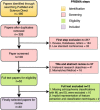A systematic review of EEG based automated schizophrenia classification through machine learning and deep learning
- PMID: 38419961
- PMCID: PMC10899326
- DOI: 10.3389/fnhum.2024.1347082
A systematic review of EEG based automated schizophrenia classification through machine learning and deep learning
Abstract
The electroencephalogram (EEG) serves as an essential tool in exploring brain activity and holds particular importance in the field of mental health research. This review paper examines the application of artificial intelligence (AI), encompassing machine learning (ML) and deep learning (DL), for classifying schizophrenia (SCZ) through EEG. It includes a thorough literature review that addresses the difficulties, methodologies, and discoveries in this field. ML approaches utilize conventional models like Support Vector Machines and Decision Trees, which are interpretable and effective with smaller data sets. In contrast, DL techniques, which use neural networks such as convolutional neural networks (CNNs) and long short-term memory networks (LSTMs), are more adaptable to intricate EEG patterns but require significant data and computational power. Both ML and DL face challenges concerning data quality and ethical issues. This paper underscores the importance of integrating various techniques to enhance schizophrenia diagnosis and highlights AI's potential role in this process. It also acknowledges the necessity for collaborative and ethically informed approaches in the automated classification of SCZ using AI.
Keywords: AI; EEG; Schizophrenia (SCZ); classification; deep learning; machine learning.
Copyright © 2024 Rahul, Sharma, Sharma, Nanda and Sarkar.
Conflict of interest statement
The authors declare that the research was conducted in the absence of any commercial or financial relationships that could be construed as a potential conflict of interest.
Figures







References
-
- Aggernaes A. (1994). Reality testing in schizophrenia. Nordic J. Psychiatry 31 47–54.
Publication types
LinkOut - more resources
Full Text Sources

